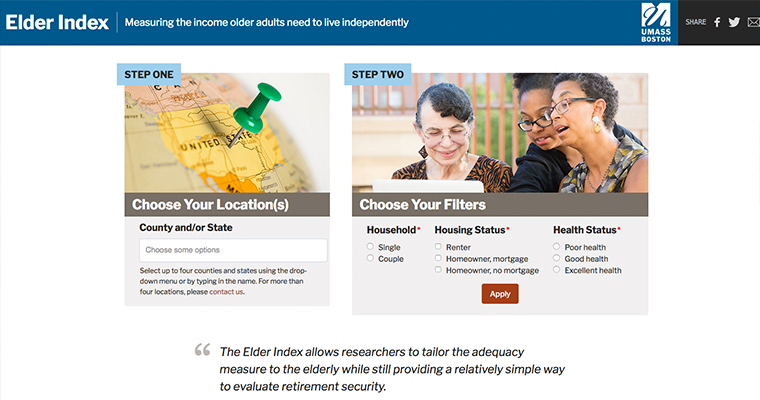UMass Boston Report Finds Far Greater Rates of Economic Insecurity Among Older Adults of Color
The challenging goal of elder economic security – having enough income to live independently and afford a no-frills budget in later life -- is dramatically more difficult for older adults of color across America, new research from the University of Massachusetts Boston shows.

“ Nationwide, the pattern of higher rates of economic insecurity among older adults of color is clear. ”
Half of all older adults living alone and 23 percent of older couples are unable to achieve that goal and live with some degree of economic insecurity, according to the McCormack Graduate School’s Gerontology Institute. A new report calculating racial disparities within those numbers shows rates of economic insecurity among Black, Latino and Asian older adults far exceeding those of white adults and the overall national average.
The report also details the economic insecurity levels of older adults of color in individual states and the states in which racial disparities are greatest.
“Economic security is a serious problem for older adults across the United States,” said professor Jan Mutchler, the lead author of the UMass Boston report. “But the situation is much more dire among older adults of color and the economic impact of the COVID-19 pandemic has almost certainly made their economic circumstances even worse.”
The report found that, among Black older adults, 64 percent of singles and 34 percent of couples were economically insecure. Among Latino elders, 72 percent of those living alone and 49 percent of couples had income insufficient to meet basic costs where they lived. Among older Asian adults, 59 percent of singles and 36 percent of couples were unable to reach economic security.
Among white older adults, 47 percent of singles and 21 percent of couples were economically insecure.
The report determined rates of economy security using expense data generated by the Elder Index, UMass Boston’s free online resource that calculates realistic monthly expenses for older adults in every state and county in the United States. It matched that information with state-level data on the incomes of older adults by racial group to determine levels of economic insecurity.
“Nationwide, the pattern of higher rates of economic insecurity among older adults of color is clear,” said Mutchler. “But there are individual states and regions of the country with significantly higher rates of insecurity and levels of disparities.”
The rates of economic insecurity experienced by older Black adults were higher than those of their white counterparts in nearly every state in America. The rate for Black singles ranged from 46 percent in West Virginia to 80 percent in Rhode Island. Disparities in rates of economic insecurity between Black and white older single adults were highest in the District of Columbia (39 percentage points), Rhode Island (29 percentage points), and South Carolina and Mississippi (each 26 percentage points).
Economic insecurity rates were also higher for Latino older adults, compared with white elders, in nearly every state in which there are enough data to calculate the risks. Latino elder economic insecurity ranged from 38 percent in Kentucky to 90 percent in Massachusetts. Disparities in elder economic security rates between single Latino and white older adults exceeded 25 percentage points in 13 states and were highest in Rhode Island (37 percentage points).
The rate of economic insecurity for older Asian adults was higher than that of their white counterparts in most states for which there was sufficient data available to compare the risks. The rates for single older Asians ranged from 35 percent in Indiana to 80 percent in Massachusetts. The disparity in rates between single Asian and white older adults was highest in Minnesota (31 percentage points).
The economic insecurity report includes tables presenting economic insecurity rates on a state-by-state basis, by racial group for singles and couples.
About the Gerontology Institute
The Gerontology Institute conducts research and policy analysis in the field of aging, and offers lifelong learning and pension protection services to older adults. The institute’s priorities include income security, long-term service and supports, healthy aging, age-friendly communities and social and demographic research on aging.
About UMass Boston
The University of Massachusetts Boston is deeply rooted in the city's history, yet poised to address the challenges of the future. Recognized for innovative research, metropolitan Boston’s public university offers its diverse student population both an intimate learning environment and the rich experience of a great American city. UMass Boston’s colleges and graduate schools serve 16,000 students while engaging local and global constituents through academic programs, research centers, and public service. To learn more, visit www.umb.edu.
